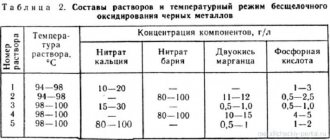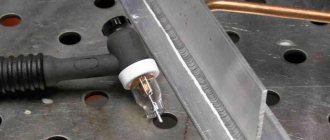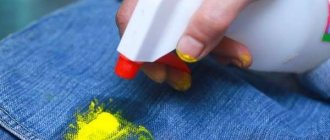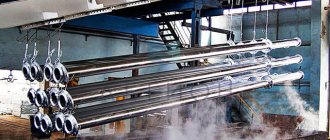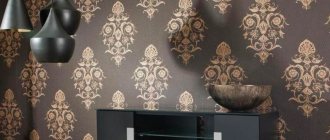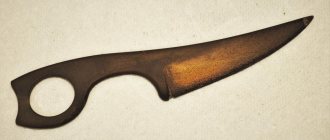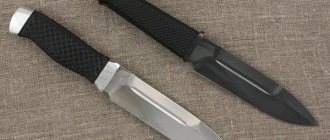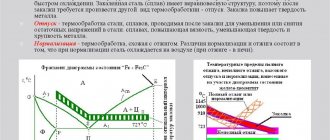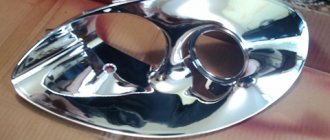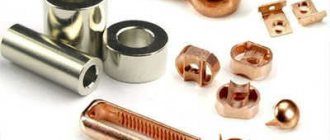- November 12, 2018
- Weapons and ammunition
- Valeria Antonova
Every hunter considers it his duty to carefully monitor the condition of his gun, because this is not only a matter of aesthetics, but also, to a greater extent, safety. Metal parts are exposed to moisture, which can lead to corrosion. In this article, we will consider a popular metal processing method that is used to protect the steel of guns.
What is bluing?
Over time, under the influence of water and temperature, weapons lose not only their external characteristics, but also their functionality. Corrosion can spread on metal very quickly if the surface is not protected.
Blueing is the application of a thin film of oxides to the surface of the metal, which prevents the occurrence of corrosion, protecting the metal from destruction. The metal-crystalline coating has water-repellent properties and gives the surface of the gun a dark, blue-tinged color.
How does bluing work and how to explain the process from a chemical point of view? Powerful oxidizing agents, when they reach the surface of a metal, react with it. As a result, metal oxides are formed on the surface layer. The thickness of this layer can be different: 1-10 micrometers. It is the thickness of the oxide film that affects the resulting color of the metal. He can be:
- yellow;
- iridescent (tarnish color);
- cherry;
- brown;
- blue;
- grey.
Different thicknesses of the oxide film are obtained as a result of using different types of bluing. What types of bluing exist and are currently used by hunters?
Types of bluing
There are a large number of types of bluing. A variety of means are used. Some of them can be used at home, others are used on an industrial scale by weapons manufacturers. We list the most popular bluing options that an ordinary user can carry out:
- Alkaline. It is carried out using oxidizing agents. The process itself is performed at a temperature of +140-150 °C. It is better to carry out the process outside the living space, since when metal is blued, a toxic, unpleasant odor is released. A thin film of oxides forms on the metal surface. This is what protects the product from rust.
- Acidic. The metal is immersed in an acid solution for a certain time.
- Thermal. The oldest type of bluing. The process involves strong heating of the metal in the open air. The metal reacts chemically with oxygen and oxidizes.
Each type of metal bluing at home includes several subcategories, which may differ in the compositions or processing technologies used.
Give the product a presentable look
A dark matte shade can give a stylish design to an ordinary knife. The blade, coated with an oxide film, looks very unusual and attractive. The same can be said for a number of other items. This need is especially relevant when the item is already old.
The technology is also used for artistic purposes, when a creative approach is taken to decorative elements of the interior.
Preparatory stage
Disassemble the gun, remove all wooden elements. Before starting the process of bluing the weapon, it is necessary to prepare the metal surface. Wash the gun thoroughly, clean the metal parts with a sponge, use a soap solution. After cleaning, rinse the parts with clean running water and wipe dry with a suitable cloth. If desired, you can remove the old layer of bluing. To do this, you need to use acetic acid or a rust remover.
Treat the metal with a solvent; it will help you get rid of contaminants that were not removed during washing. The metal surface must be thoroughly sanded. Use medium-grit sandpaper first, then fine-grit sandpaper. Grinding is carried out in several approaches. Finally, go over the surface with an even finer abrasive. Pay special attention to hard-to-reach places; they must be thoroughly cleaned.
If you decide to blue metal at home, it is unlikely that you will have a ready-made container at hand for carrying out the procedures. You can make it yourself. Use stainless steel sheets as the material. Bend them and weld the corners. If bluing is performed with heating, heating elements are installed under the bottom (2 x 500 watts will be enough).
Selecting the type of bluing
Depending on the existing conditions, you can choose the bluing option that is most suitable for you. If the process is carried out in an apartment, then it is better to abandon the alkaline type of metal processing, since the release of vapors with a specific odor can cause dissatisfaction with neighbors.
Remember that with the acid treatment method, the effect of the acid must be uniform, so you must have a container of a suitable size for immersing the overall elements of the gun into it. Otherwise, the resulting color after bluing may be uneven.
If you are new to this area, then avoid those bluing methods that use strong dangerous reagents (alkalies, acids), since mistakes made during the preparation of the solution can lead to catastrophic consequences.
Where are specialists trained?
Many men are wondering where they can get training to become a gunsmith. According to reviews, the most famous institute where new personnel are trained for the defense industry is the Bauman Moscow State Technical University. It is within the walls of this university that students are taught almost all existing weapons specialties. The following directions are open to future gunsmiths at the university:
- Faculty of Special Mechanical Engineering.
- "Shooting and cannon business."
- Artillery and missile direction.
- Faculty for the study of weapons and various ammunition used in modern warfare.
The duration of training lasts from 5 to 5.5 years, depending on the chosen specialty.
In Izhevsk there is a school of “Weapons Mastery”, which operates on the basis of the Izhmash enterprise. There they train to become a mechanic, specializing in repairing various types of weapons.
In the hero city of Tula there is an educational school where they teach such working professions as:
- Locksmith.
- Milling operator.
- Turner.
- CNC machine operator.
- Machine operator.
After completing their studies, students are gladly hired to work at defense enterprises in our country.
Acid oxidation
Regardless of what reagents are used, cold bluing involves oxidizing the metal surface without the use of high temperatures. This type of treatment is used in cases where they want to get a light bronze shade. Let's look at the most popular types of cold bluing.
In this case, the so-called rusty varnish is used for processing. It is a saline solution of iron. The essence of the process is to accelerate the corrosion process; treatment with rusty varnish falls into the category of cold bluing of weapons.
To work you will need:
- distilled water - 1 liter;
- steel filings - 30 g;
- metal scale - 20-30 g;
- nitric acid - 54 ml;
- hydrochloric acid - 50 ml.
The entire process must be carried out in the fresh air, away from residential premises, since evaporation has toxic properties.
Pour 50 ml of hydrochloric acid into a glass container, place steel filings, scale and nitric acid in equal parts. The chemical process will begin. When the components interact, the solution will acquire a greenish tint and a brown gas will begin to evolve. We add another portion of the components in the same proportions. In total, the initial components need to be divided into 3-4 parts, they need to be added gradually. When the reaction is complete, you should end up with a rust-colored mass, reminiscent of sour cream in consistency. Close the container tightly and leave the composition to infuse for 24 hours.
After 24 hours, add 1 liter of distilled water to the infused composition. The mass is ready for use. We apply the resulting varnish to the metal surface of the gun in a thin layer, carefully process all parts and leave the elements to dry at a temperature of +30-60 °C. Over time, the metal will acquire a light red color.
Application of rust varnish
This bluing agent is often used to obtain a smooth and even surface. It contains steel shavings, but they can be replaced with cast iron shavings. In this case, financial investments will be minimal. In this case, the workpiece must be placed in a chemical agent. The result is red or black iron oxide. This instruction, as a means for cold bluing, gives a long-lasting and effective result.
To get rid of red deposits, use a brush with fairly stiff metal bristles. As a result, only black oxide remains.
First, the metal is machined and degreased. Then the product is placed in a special composition. The bluing agent is prepared in a porcelain container. It is important to wear gloves to protect your skin. The composition is made using hydrochloric acid. It is poured in a small amount into a container. It is mixed with metal filings, nitric acid and iron rust.
The mixture is stirred well until the chemical reaction, which is accompanied by the release of gas, stops. Add water and regular vodka to the mixture in equal proportions. Finally, it is left for a certain time until it settles. Then it is drained to remove scale and salts that have precipitated.
When the mixture is ready, the metal product being processed is placed in it. It is kept until it turns black. After this, it is washed under strong pressure of running water.
In the video: bluing with rusty varnish.
Hot bluing. Alkaline method
This method is suitable for doing the bluing process yourself at home, but it is better to do it outside. To work you will need:
- water;
- sodium hydroxide;
- sodium nitrate;
- digital scales;
- stainless steel container.
Burnishing will be done when the liquid is boiling, so maintaining a constant boiling temperature is a prerequisite. The duration of the process is one and a half hours. At this time, you must constantly monitor the volume of liquid in the container and add water if necessary.
An alkaline solution is a very aggressive liquid; be sure to protect your skin and respiratory system. Do not allow alkali to get on your clothes - this will lead to instant corrosion of the material.
It is better to carry out the process in a technical room that has a good exhaust system.
Thermal bluing
This type of metal processing has been used for centuries. The essence of the process is that the metal at elevated temperatures enters into a chemical reaction with atmospheric oxygen and, as a result, a film of oxides is formed. Depending on the level of temperature maintained, you can get different bluing colors.
- golden - 246 °C;
- purple - 275 °C;
- dark blue - 310 °C.
If you want to achieve a dark blue tint to the steel, then you need to use a forge. Weapon parts are treated with citric acid and placed in a metal box with smoldering coals. This design is placed in a preheated forge. The procedure is repeated 3-4 times until the color becomes dark, with a blue tint.
Blueing a Damascus steel gun
Damascus steel is not a specific type of metal. An alloy is a mixture of steel elements and wrought iron. In the process of sour weed, a unique ornament or pattern is obtained. Different types of bluing are used for such guns; let’s look at the most popular ones.
The first method will achieve brown steel. To prepare the solution you will need:
- copper sulfate - 8 g;
- nitric acid - 30 g;
- hydrochloric acid - 2 g;
- ethyl alcohol - 30 g;
- water - 1 l.
Dissolve copper sulfate in water, then add the remaining ingredients. Let the solution sit for several days, after which we process the metal in several approaches until a rich brown tint is obtained.
To obtain black Damascus steel we use the following technology:
- carefully polish the steel;
- treat the surface with wood oil;
- sprinkle the elements with ash;
- Place the metal on hot charcoal and make sure the temperature is maintained.
After completing the procedure, let the parts cool and wash them with water and a small amount of sulfuric acid. We wash the parts in clean water and dry them, rub them with oil. After these procedures, Damascus steel will look unusual: the steel elements will remain light, but the iron inclusions will darken.
How to get a faded color?
We fill a metal box to the size of the part with small birch charcoal and place it in a well-heated forge or in a barrel with burning wood chips. When the coal heats up and begins to smolder, we place a vinegar-wiped and dried steel part into it, and then monitor the stages of its heating. At the very beginning of the appearance of blue, take out the workpiece and cool slightly in air, while cleaning it with soft charcoal.
Another method is using a special solution and without heat treatment. For it you need to get only 2 reagents: 2.5 grams of potassium hexacyanoferrate, popularly called red blood salt and which is a powerful oxidizing agent, as well as iron sesquichloride. Both ingredients dissolve perfectly, so feel free to pour 0.5 liters of water into each in a separate container, then combine the resulting liquids into a single mixture.
There are more complex methods of blueing, but we will turn to those that are simpler. Oxidation can be carried out not only with solutions, but also with melts of various substances. In particular, a dark blue color can be given to a steel product by immersing it in molten sulfur, into which a small amount of soot is first mixed after turning into a liquid state.
Steel, which acquires various shades of gray as a result of bluing, looks beautiful, and a fairly strong film of oxidized metal is obtained that protects against rust. You can obtain a color in this spectrum in a simple way, which, however, is only available for small products. You will need 70 grams of copper nitrate and 30 grams of denatured alcohol, the first reagent is a salt, the second is an alcohol.
The following components are needed: 24 percent hydrochloric acid - 120 grams, 90 percent alcohol and water - 100 grams each, sublimate - 40 grams and 2 times less bismuth chloride with copper chloride. Mix acid and water, add alcohol and divide the resulting liquid into 3 equal parts. Pour the last 3 components related to salts separately into each part of the solution and then mix everything in one container. The steel product is immersed in the resulting bath for half an hour, after which it is removed and boiled in clean water. If necessary, repeat the process.
To achieve a faded color on the surface of your product, you need to know very well at what temperature it appears and what duration of heating is necessary to fix it on the metal. The main condition: firing with a flame must take place for a strictly defined time. Therefore, if you want to enhance your product with a tan color, choose a small item, because it will be almost impossible to heat a large area of metal evenly on a gas stove or blowtorch.
Once you have achieved the desired color, immediately remove the product from the heat and let it cool. Then rub it with oil to set the color.
Chemical bluing recipes
There are now many different combinations of chemicals available for blued steel. Let's look at some of them.
Recipe 1
To prepare the solution you will need:
- red blood salt - 2.5 g;
- iron sesquichloride - 2.5 g;
- water - 1 l.
First, two solutions are prepared, the blood salt is dissolved in 500 ml of water, the second part of the liquid will be used to prepare a solution of iron sesquichloride. We combine these parts and pour the resulting solution into a glass container. Fill metal parts with liquid. The bluing of hunting rifle barrels and other metal parts must be carried out until you are satisfied with the resulting shade.
Recipe 2
Prepare the following ingredients:
- sodium sulphate - 70 g;
- lead sugar - 17.5 g;
- water - 1 l.
Dissolve the salts in an equal amount of water separately, then mix the solutions. The solution should be heated slowly to a boil. During the boiling process, metal elements will become covered with a dark blue coating. When the color becomes uniformly saturated, the gun bluing process can be considered complete. Carefully remove the metal parts and rinse them with water.
Recipe 3
This recipe will allow you to achieve a bright brown shade of iron. To prepare the solution you will need:
- olive oil - 500 g;
- antimony trichloride - 500 g.
The ingredients are mixed, resulting in a thick paste. The mixture must be applied to the previously prepared surface of the gun, paying attention to all hard-to-reach places, and left for 24 hours. After this, the paste is removed, the metal is rubbed with a woolen rag and a new layer is applied, which must also be left for 24 hours.
You can reduce the time of exposure to the paste by heating the metal. To do this, you need to maintain the temperature at +220 °C. In this case, the reaction speed will increase significantly, and a few minutes will be enough to blue the weapon at home.
How to clean rifled weapons?
People on forums often ask questions about how to clean weapons and why it is needed. If you properly lubricate rifled guns, pistols and carbines with gun oil after each shooting, they will serve you for a long time without complaints.
Beginning athletes are often interested in how to clean rifled weapons. In order to prevent breakdowns, delays and metal corrosion, a number of rules should be followed:
- The rifled barrel must be cleaned in a certain sequence: first get rid of carbon deposits and harmful deposits in the breech, and then begin processing the opposite side. That is, cleaning should be done in the same direction in which the bullet flew during shooting.
- Using the same principle, it is necessary to guide the cleaning rod with a clean rag wrapped around it. It is also allowed to clean the bores with a cleaning rod equipped with a brush.
- Moving the cleaning rod in the opposite direction is highly undesirable, since in this case scratches may form on the metal part of the weapon.
- After each procedure, the brush must be cleaned of carbon deposits and metal parts that have settled on it.
- A brush for cleaning weapons must be purchased with stiff bristles, since soft hairs very quickly become clogged with deposits as a result of the combustion of gunpowder. And it is extremely difficult to get rid of them.
- Rifled weapons must be cleaned immediately after shooting. Failure to do so will inevitably lead to unsuitability of the product.
- It is necessary to clean the barrels and components of a rifle with rifling even when it is not used for its intended purpose. As a rule, it is enough to carry out this process once every few days. Even if the weapon is in the closet, it needs to be lubricated and cleaned periodically.
- If the weapon was fired, it is advisable to immediately begin the procedure in question. After two days it is recommended to repeat it. Only after this the rifled weapon is ready for long-term storage. Do not forget that even with long-term storage, shotguns and pistols must be subjected to a cleaning procedure.
- The most vulnerable elements in a weapon are the muzzle and the bullet exit of the barrel. They need to be especially carefully cleaned and generously lubricated with gun oil.
- It is highly undesirable to use compounds and lubricants that are not intended for cleaning weapons. You should also not apply homemade alkaline compounds to metal. If you neglect this recommendation, you can ruin your expensive firearm.
- After thoroughly cleaning the barrel, all metal components and mechanisms must be lubricated with special oil, which is designed to protect against corrosion.
Safety precautions
The process of bluing metal parts of weapons can create an environment hazardous to health. A chemical reaction of the redox type is accompanied by the release of a caustic gas that can cause damage to the respiratory system, so take care of respiratory protection in advance. When carrying out the bluing process outdoors, be sure to wear a respiratory mask. Do not lean towards the container with reagents, use gloves to protect the skin of your hands and special clothing that you do not mind getting damaged.
If the chemical reaction between the reagents is violent, do not mix the entire volume of substances at once. Add the components in the required proportions in parts so that you can control the progress of the chemical reaction.
Make sure that the room is ventilated if you are carrying out the bluing procedure in a residential area. Do not exceed the permissible temperature of the active fluid.
Under high-temperature conditions for bluing, be sure to monitor the fire safety of the building in which the process is carried out and your own safety. Use heat-resistant material as protection.
Blackening
We will present another option on how to burnish steel with your own hands. This option is as simple as possible to use. It is suitable even for those who live in an apartment or simply do not want to carry out such a procedure with heating an alkaline or acidic liquid composition. This is bluing with a brush. Special products are sold, for example, the domestic “Raven 3” or the foreign “Prague Oxide”.
The technology is very simple to apply - you first need to remove the top fatty layer, that is, degrease the surface. But there are some disadvantages:
- It is difficult to provide a good film in areas where access is difficult. Therefore, it is better to immerse crafts with complex configurations completely in containers.
- The layer is not very durable and is not resistant to mechanical damage.
